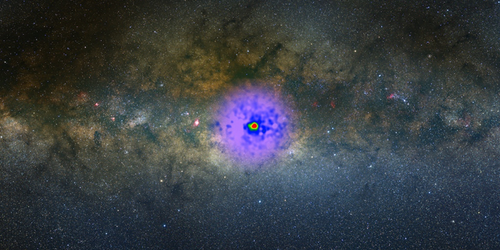New Hope for Milky Way Dark Matter
Gamma rays radiating from the heart of our Galaxy have an on-again, off-again relationship with dark matter. In 2009, the Fermi Gamma-ray Space Telescope detected a surplus of gamma rays coming from the center of the Milky Way, which astronomers attributed to annihilations between dark matter particles. A few years later, the blame was placed on pulsars (see 4 February 2016 Synopsis). Now a new study by Rebecca Leane and Tracy Slatyer, both of the Massachusetts Institute of Technology (MIT), Cambridge, shows that there was a problem with the pulsar analysis, and a contribution from dark matter could have gone unnoticed.
In 2016, an MIT-Princeton team that included Slatyer argued that gamma rays from pulsars and those from diffuse dark matter, which is thought to permeate our Galactic Center, should differently light up pixels in the Fermi images. Modeling the emissions from these sources, they predicted that photons from pulsars should clump together, creating “hot spots” in the images, while dark-matter-produced gamma rays should give them a smoothly varying glow. After accounting for known sources of gamma rays in the Fermi images, the team reported that the measured pixel-to-pixel variations overwhelmingly favored pulsars as the source of the gamma-ray excess.
But now Leane and Slatyer say that the pulsar sleuthing may have left some gamma-ray-producing cosmic bodies unaccounted for. When they injected a fake dark matter signal into the Fermi data, they found that the image analysis mistakenly identified that signal as originating from pulsars. Using simulated data, they showed that a dark matter signal gets missed if there are point sources, such as hot gas clumps—a class of objects left out of the original study.
A dark matter signal may therefore still lurk in the Fermi data. Leane and Slatyer hope that refinements to their analysis algorithms and upcoming observations will help settle the debate.
This research is published in Physical Review Letters.
–Christopher Crockett
Christopher Crockett is a freelance writer based in Arlington, Virginia.





